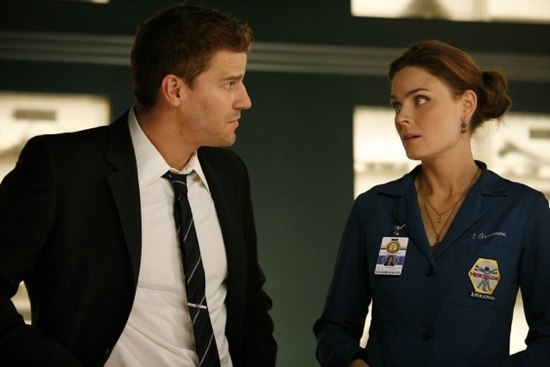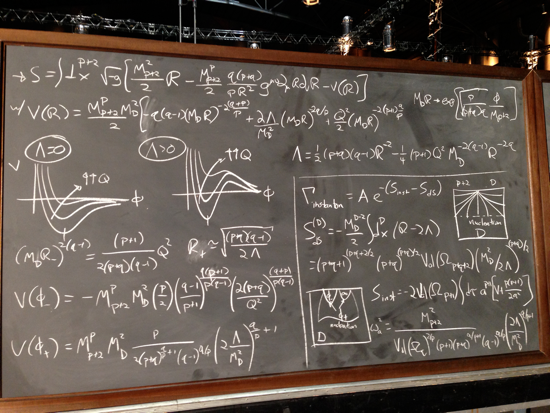A few years ago, not long after we moved to LA, Jennifer and I got a call from some of the writers on the TV series BONES. There’s already a science component to the show, which features brainy forensic anthropologist Brennan (Emily Deschanel) and her team of lab mates working with fiery FBI agent Booth (David Boreanaz) to solve crimes, most of which involve skeletons and physical evidence in some crucial way. This time they needed some physics input, as they wanted the murderer to be a researcher who used their physics expertise to carry out the crime, and were looking for unusual but realistic ideas. We were able to provide some crucial sociological advice (no, professional research scientists probably wouldn’t meet at a Mensa conference) and consulted with experimentalist friends who would know how to use radioactive substances in potentially lethal ways. I won’t say who, exactly, but when the episode aired they ended up calling the research institute the Collar Lab.
Apparently physicists are a suspiciously violent bunch, because tonight’s episode features another scientist suspect, this time played by Richard Schiff of West Wing fame. I got a chance to consult once again, and this time contributed something a bit more tangible to the set: a collection of blackboards in the physicist’s office. (Which, as in all Hollywood conceptions, is a lot more spacious and ornate than any real physicist’s office I’ve ever seen.) You can see the actual work tonight (8pm ET/PT on Fox), but here’s one that I made up that they didn’t end up using.
It does look like our professor is a theoretical cosmologist of some sort, doesn’t it? The equations here will be familiar to anyone who has carefully read “Dynamical Compactification from de Sitter Space.” The boards that actually will appear on the show are taken mostly from “Attractor Solutions in Scalar-Field Cosmology” and “A Consistent Effective Theory of Long-Wavelength Cosmological Perturbations.” Hey, if I’m going to write down a bunch of equations, they might as well be my equations, right?
But I actually got to be a little more than just a technical scribe. (Although that’s not an unimportant role — not only are the equations themselves gibberish to non-experts, it’s difficult for someone who isn’t familiar with the notation to even accurately transcribe the individual symbols.) No spoilers, but the equation-laden blackboards actually play a prominent role in a scene that appears late in the episode, so I was able to provide an infinitesimally tiny amount of creative input. And the scene itself (the overall conception of which belongs to writers Emily Silver and Stephen Nathan) packs quite an emotional wallop, something not typically associated with a series of equations. I haven’t seen the finished episode yet, but it was a great experience to actually be present on set during filming and watch the sausage being made.


Good to know Hollywood is taking an interest in attempting to be scientifically correct! I have all your books and your lectures from The Great Courses. May I be so bold as to make a small contribution to your contributions: even though it is now known how to split atoms, you may well be advised to avoid splitting infinitives!! Although I am an old curmudgeon, I consider myself to be a long time groupie in the Sean Carroll fan club!
Hollywood teaches America (and, unfortunately, the rest of the world under it’s spell,) that scientists are malicious and sinister types and invariably the bad guys, the types from which James Bond-like heros save humanity. Few are Hollywood’s creations, and far between, in which the scientist is the good guy, and the two instances Sean tells us about are no exception. And the defamation catches, and it’s certainly part of the problem that America has to massively import scientists in order to stay sharp. So I don’t see why a true and benign scientist should collaborate with the enemy, cool as they may be.
Should look more modern and have transparent led writing boards like they do.
Very cool! It’s nice when Hollywood tries to get it right, and you were the right man for the job.
Fringe probably could have used your help too. I has liked that show, but their science was off.
Del, this is a show where scientists are the good guys in every single episide (Bones is an anthropologist, and leads a team of other scientists). These kinds of shows have a really big impact on public perceptions of science, as you suggest, but many of them are portrayed as heroes, and have inspired young people to pursue careers in science and medicine. When a show does a decent job of portraying scientists (and science), particularly with a strong female character, that’s a good thing in my book.
I wonder if a really geeky board would have the mathematics literally expressed in TeX math commands instead.
I think Sean has gone native. I’ll check it out. Physicists on TV… what a concept. I hope you have broken the lead shielding, I mean lead ceiling. Who can play Fermi?
Rev Dave:
With Carrolls gone showbiz, time to adjust some icons.
Billy Wilder on the (love) story of neutrinos: Fermi La Douce.
Mel Gibson as Frank Wilczek in Strongforce: ‘They can take our electrons, but they will never take our asymptotic freedom!’
A Terence Malik-Carl Sagan collaboration: Pale Blue Dot on a Thin Red Line.
You said you wanted to write your own equations. Good point.
I am a chemist writing fiction in my language Tamil. In order to be scientifically authentic I use my own research.
I just got done watching the episode you’re talking about and caught myself getting a bit teary eyed at the end. It does indeed pack an emotional wallop. I went looking to see if the equations they used were accurate. I hate finding out things like that were faked . . . throw up a bit of gibberish nobody understands, say it means something profound and go for the easy emotional button-push.
It was a pleasant surprise to end up here and find out all the gibberish actually meant something.
If your infinitesimally small creative input was the equation at the end . . . well, it might have been small, but it was perfect.
From someone who enjoys well told stories . . . thank you for your contribution!
Thanks!
Pingback: ‘Bones’: At Rest - Musings Of A Mild Mannered Man
Having been an extra on many television and movie productions, I know that many production teams worry right down to the last detail about….details!! You’d be surprised, but there is a whole subculture of “examiners” (for want of a definite term) who examine every second of a television show for errors. Something like, “Booth was wearing brown socks at the beginning of the scene, but was wearing blue socks when he strolled away!!” (and socks visible for .3 seconds at the end). There is seemingly a ‘contest’ with every show on television, with people sending mail about every production mistake (e.g. running shoes from the 21st century in a 1995-year scene).
I think this kind of cool that your contributions can be used in this way. I see a lot of consulting taking place by different scientists like yourself, so to me, if you are going to write the equations it might as well be the real ones. Haven’t see the episode yet, but I look forward too.
Best,
Remember it was actress Hedy Lamar that received a patent for a torpedo guidance system back in the WWII era. You never can tell who will get inspired by physics!
It’s time’s like this I really start to think, whatever I was thinking, that it would be good idea to just study electronics instead of physics.
Finally saw the episode. A few thoughts here.
It was interesting. There seemed to be written in the story, a disconnect between a daughter and one’s father, and somehow, the way in which the scientist delved into his work, might of have him lacking in the way of showing affections which should have existed.
I mean, as one looks at the scene later, when he wants to speak, he speaks in a way using his math to describe his daughters journey through life. This is interesting, that such affection can be only spoken in that abstract way.
It raise the question about the coldness of such simplification, yet , also in relation to the scene, a paying of tribute to his daughter, something which engages the viewer that such math could be very elegant.
Best,
I loved that scene at the end where the father described his daughter’s life as a series of equations for movement. Tears were shed. I found it to be beautiful. Thank you Sean.